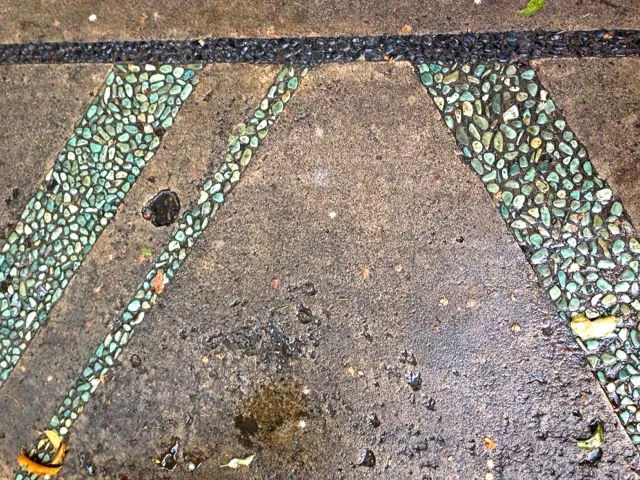Circadian Rhythms
menteng sidewalk
Where's Waldo of Stone Flowers
Stones on the sidewalks of Menteng, Jakarta are inset to form paths within paths. The stones are shades of green and ash and when wet, glisten like panhandlers gold. Looking closer, there are flowers interspersed amidst seemingly random patterns of rock—rock crushed from far away brought in for the ironic pleasure of those who rarely look down. Yet, nothing is random about the creation of this flower field. The flattest part of every stone has been inverted and slowly, steadily, carefully pushed down into gritty stiff earth. Not one neighbor touches another. Not one. How is such focus even possible for surfaces meant only for feet? Who were the workers? Did they wear conical hats and did they have to force open their eyes, blinking repeatedly as they came up from the squat position, levering straight their backs to gain perspective of the urban masterpieces they had done? Their looks must have been Zen—quiet, contemplative, expressionless, no choice.
Every twenty minutes or so, the local bus or Kopaj, rumbles by layering hot subsidized soot. The stone sidewalks are anachronistic to these steel spewing beasts full of morning riders with expressions not unlike victims. The cost of the ride is two thousand Rupia or twenty cents. In case one would forget, there is the tap-tap-tap of the bus worker’s coin. Tap-tap-tap,
Tap-tap-tap. To avoid monotony, a change of coin type—100, 200 or 500 aluminum: chip-chip-chip or click-click-click; or striking surface— chut-chut-chut or pik-pik-pik. The busman adds high-pitched exhortations of unclear origin— neither singing, nor speech—as he moves down the bus aisle in a kind of urban orchestrated shake down. The bus lurches and jerks against the heavy Jakarta traffic. The passengers who stand careen forward. For those seated, necks whip in synchrony, first to the left, then to the right. A ukulele player climbs aboard, crooning street love songs. Roles are interchangeable between audience and performer in this impromptu skit. Cheap tickets come for the price of syrupy sweat, tall people lodge awkwardly in ninety-degree cushion less seats, women arrange their shawls to cover rare skin casting intermittent color in billowing arcs.
The head covers worn by Muslim women here are called Jilbabs. As 87% of Indonesia’s population is Muslim and more than 50% of the population women, the Jilbab in Indonensia is the moving canvas of everyday scenes. In buses and out, on streets, in offices, on motorcyles, in parks, on runways,
Sulawesi nurses, midwives and obstetricians in Jilbab








